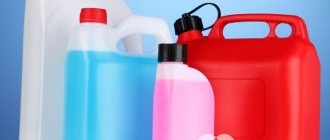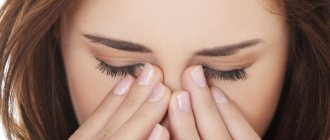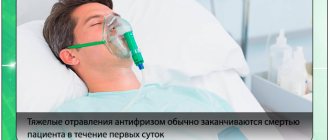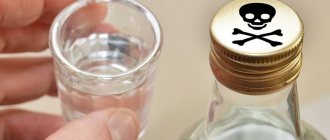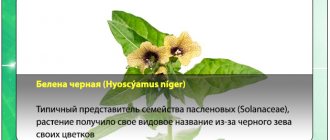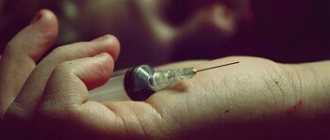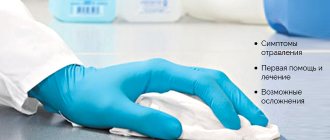Nowadays, few people will be surprised by the fact that poisoning with household chemicals is quite possible. It has become such a part of human life that it can be found in, perhaps, every home. Household chemicals include:
- preparations for removing grease from the surfaces of slabs and plumbing fixtures;
- acetone and turpentine solvents;
- alkaline, alcohol and acid detergents;
- foaming hygiene products (shampoos, gels);
- laundry detergents (washing powder, etc.);
- aggressive cleaning agents based on acids and alcohols for heavy soiling;
- cosmetic alcohol products (lotions).
Any of these products, if handled incorrectly, can be poisonous and lead to poisoning.
According to the international classification of diseases, the ICD 10 code for such poisonings is X 49.
Causes of poisoning
The main factor leading to intoxication of the body is violation of instructions for the use of hazardous chemical compounds used in everyday life.
Among the most common errors are:
- negligent attitude towards storing toxic substances (in places where children have access to them);
- excessively frequent use of drugs, leading to the accumulation of toxic components in the body;
- inaccurate use of chemicals, allowing them to come into contact with the skin, eyes or respiratory tract;
- erroneous ingestion of chemicals;
- inhalation of toxic fumes when spraying aerosols;
- storing chemicals in available containers without indicating the name of the product.
Young children often become victims of improper storage of drugs used in everyday life. A child may like the beautiful packaging, reminiscent of a bottle of juice, so he safely swallows shampoo or dishwashing detergent, or tastes the washing powder left by adults in a visible and accessible place.
Almost all household chemicals pose a danger to the human body due to toxicity. Poisoning with soap, detergents and cleaning products account for approximately a third of registered cases of intoxication (ICD-10 code X40-X49).
There are a number of causes of detergent poisoning:
- Violation of the instructions for use, use in an unventilated area.
- Violation of storage rules. Often chemicals are left in places where children, attracted by the bright label, have the opportunity to get it themselves.
- Too frequent use of products leads to the accumulation of toxins in the body.
- It is not uncommon for a person to confuse water and chemicals, drinking the latter instead of the former.
- Intoxication is caused by contact of a toxic substance on unprotected skin or through the respiratory tract.
- When toxic fumes are inhaled, irritation and ulcers appear on the mucous membranes of the mouth and nose.
prevalence
In 2020, the NPCC reported that their call centers received almost 2.2 million calls.
Among all age groups, 79.4 percent of reported cases were unintentional, 16.8 were intentional, and 2.4 percent were adverse reactions to food, drugs, or other substances.
For children under 6 years of age, 99.3% of exposures to all poisons were accidental. Only 36.9 percent of adolescent and about 61 percent of adult cases were unintentional.
According to a 2020 report from the American Association of Poison Control Centers (AAPCC), children under 5 accounted for about 47 percent of the total poison exposures.
They also reported that dishwashing soap was among the top five most common exposures for children ages 5 and younger, accounting for about 11 percent of poisonings.
The good news is that most soap exposures were non-toxic, minimally toxic, or had only minor effects.
Types of poisoning with household chemicals
The benefits of using detergents and cleaning products are undeniable. However, handling them requires strict adherence to instructions. Otherwise, there is a high probability of poisoning at home with a variety of powders, gels and chemical solutions that are widely used when working around the house and in the garden.
Surfactant poisoning
The category of surfactants includes soap, shampoos, washing and cleaning liquids. Aggressive washing powders used to remove stains are especially dangerous.
Poisoning with dishwashing detergents in an adult occurs due to prolonged use without gloves. You should also not ignore recommendations about the need to rinse dishes with plenty of running water. In addition, harmful elements accumulate in the body when their vapors are inhaled and penetrate the skin.
The danger of surfactant poisoning lies not only in the occurrence of a local allergic reaction. These toxic compounds penetrate muscle structures and negatively affect the condition of the liver, respiratory organs, digestion, and brain centers.
Liquid oxidizers containing chlorine and oxygen are used to remove blockages in sewers, bleach fabrics and remove stains from them, as well as for disinfection. Violation of the instructions for their use often causes serious intoxication of the body.
Prolonged inhalation of vapors from cleaning products with oxidizing elements causes vasospasm, swelling of the nasopharyngeal structures, and negatively affects the condition of the kidneys and digestive organs. In addition, poisoning by evaporating particles of chlorine and aggressive oxygen compounds is fraught with burns of the mucous membranes of the respiratory tract, increased blood pressure and the development of anemia.
Poisoning by cleaning products for gas stoves, microwaves, other kitchen utensils, water supply and sewerage units also poses a danger to the body of adults and children.
Powdered chemical compounds contain:
- lime elements;
- ammonia (ammonium chloride);
- sodium silicate;
- sodium bicarbonate (baking soda).
Absorption of aggressive alkali elements through the skin and prolonged inhalation of dangerous particles leads to poisoning, which occurs with the following complications:
- irritation of the digestive organs;
- swelling of the lungs and brain structures;
- the likelihood of internal bleeding;
- chemical burns of the eyes and mucous membranes of the respiratory system.
The severity of intoxication depends on the concentration of toxic elements entering the body. Severe alkali poisoning becomes a prerequisite for the development of irreversible consequences ending in death.
The acids contained in many disinfectants and surface cleaners can cause serious damage to the esophagus and stomach if they enter the body (either by mistake or intentionally ingesting them). Poisoning by acids present in bleaching and detergent products of the chemical industry proceeds similarly to poisoning by alkalis.
When using phosphorus-containing insecticides and repellents used against parasites and insects (Ammophos, Karbofos), the risk of poisoning with toxic substances is quite high. Intoxication can occur when aerosol preparations are sprayed incorrectly and recommendations for using the necessary protective equipment (respirators, masks, gloves) are ignored.
Toxic substances contained in household chemicals, if they enter the body, can cause poisoning and death. Therefore, any discomfort after using chemicals requires immediate consultation with a doctor.
Ways of toxins entering the body
The chemical nature of household products is different. For these purposes the following is used:
- Surfactants are surfactants found in soaps, dishwashing detergents and powders.
- Oxidizing agents contained in oxygen and chlorine bleaches.
- Hydrocarbons contained in turpentine and gasoline.
- Alkalis used for cleaning sewer pipes.
- Acids, such as acetic acid, found in table vinegar.
- Alcohols.
Surfactants have a strong effect on the body. In case of intoxication, they cause damage to the digestive tract, foaming at the mouth, vomiting, stomach pain, and liver dysfunction. Such substances can accumulate in the body, causing chronic poisoning.
Antidote for mercury poisoning
Oxidizing agents are extremely aggressive and cause severe liver damage, burns and erosive injuries to the digestive tract, and promote hemolysis.
Alkalies can affect the gastrointestinal tract with the formation of erosions and ulcers; they penetrate deeply, which aggravates the situation.
Acids contribute to the appearance of erosive ulcers in the digestive tract and on the skin.
Alcohols cause liver dysfunction.
There are many ways of infection; toxins can penetrate through the respiratory tract, mucous membranes, skin, and mouth. This can happen in different ways:
- with frequent use of chemicals without protective gloves or a mask;
- in case of contact with unprotected areas of the skin, eyes, mucous membranes;
- when swallowed (young children may accidentally taste brightly colored shampoos or tasty-smelling soaps);
- when inhaling vapors of concentrated substances, powders, in the absence of normal ventilation in the room.
If ingested, the chemical causes swelling of the lungs and mucous membranes, poisoning, respiratory arrest and disruption of the nervous system. In particularly difficult cases, gastrointestinal disorders, cardiac dysfunction and even cardiac arrest occur. The victim becomes inadequate, he cannot correctly assess situations, and loses consciousness.
The first measures in case of poisoning depend on the type of toxin and the general condition of the patient. In case of poisoning with various vapors and powders, it is necessary to ensure an influx of fresh, clean air and eliminate anything that interferes with breathing. If the cause of the injury is gasoline, turpentine or other similar substances, it is necessary to prevent contact with them and, if possible, remove them from the surface of the skin or mucous membranes.
If substances have entered the body, under no circumstances should you induce vomiting or do rinsing - this will only worsen the situation! This is especially important for poisoning with soda, ammonia, and quicklime. You should also not try to neutralize toxins on your own or induce vomiting. Local anesthetics can be given, but only for external lesions.
Signs and symptoms
Symptoms of intoxication with household chemicals manifest themselves in different ways. If more than 2 precise signs of intoxication occur, you should take action and seek help from a doctor. Main manifestations of the disorder:
- manifestation of nausea and gag reflexes;
- systematic pain in the abdominal area observed in a child;
- temperature increase;
- disorders of the defecation process (classic diarrhea);
- the appearance of spots, itching and hives;
- visual impairment;
- irritation of the mucous membrane of the eyes;
- convulsions;
- respiratory reflex failures;
- cough syndrome;
- dysfunction in urination (different shade of fluid).
https://www.youtube.com/watch?v=R09Ff5qI6Rw
If you drink detergents, problems with the digestive tract will be guaranteed. There will be vomiting of blood, severe forms of mucosal damage and intestinal bleeding. The result is shock, which can result in death.
Most washing powders and cleaning liquids are toxic to people. In order to avoid poisoning, you should study the instructions for use (special containers) and use the products for their intended purpose.
Surfactants are represented by soaps, detergents and various shampoos. Synthetic powders remove greasy and other stains. The compounds provoke the appearance of foam in the mouth, gastrointestinal pathologies, gag reflexes, and abdominal cramps. Liver dysfunction can result in dangerous signs. Chemicals can cause redness of the skin. Elements accumulate in muscle structures, the brain region and parts of the liver.
Key signs of intoxication:
- Foam formations in the mouth (superficial type of disease).
- Spread of pain in the stomach and parts of the absorption organ (food format).
- Manifestation of gag reflexes, especially in a child.
- Difficulty in breathing (due to inhalation of chlorine vapor, which gives a chemical effect).
- Liver dysfunction at various stages if inhaled for a long time.
Household chemicals are effective in removing stains that cannot be washed off with water. The elements accumulate in the human body during inhalation of vapors. Healthy skin is susceptible to destruction when in contact with compounds. Poisoning from washing powder can be avoided by following safety precautions at home.
Chlorine and oxygen structures (liquid) are widely used to disinfect various surfaces that affect the destruction of organic elements. The substances are indispensable for removing contaminants in sewer and plumbing units. Bleach and stain removers can cause serious poisoning if used incorrectly.
With prolonged contact with oxidizing vapors, severe swelling of the oral cavity and respiratory organs forms. The upper part of the larynx begins to experience irritation and suffocation. A common symptom is itching around the eyes and increased tearing. Cough and dysfunction of the breathing process will be dangerous. A chlorine-containing product is dangerous to the body due to its evaporation.
If the influence of chemistry is not eliminated in time, a number of diseases may occur:
- the course of vascular atherosclerosis;
- development of anemic pathologies;
- the appearance of brittle hair, dullness and loss of keratinized skin appendages;
- increased blood pressure (vessels need to be cleaned);
- systematic elimination of red blood cells;
- liver pathology, erosive processes of the mucous membrane;
- the stomach and intestines receive burns of varying degrees.
Alkalis
Poisoning with dishwashing detergent is a common option. Alkali is used to remove blockages in sewer systems. Detergent-type compounds are relevant for cleaning dishes and various kitchen utensils. Popular types of alkali include sodium silicate, lime, ammonium chloride (classic ammonia) and soda. A high level of concentration of compounds upon contact with the skin provokes a number of symptoms:
- Intense thirst.
- The development of diarrhea and vomiting disorders; the blood may contain alkali, which damages the walls of the stomach and intestines.
- Formation of swelling in the brain, headaches.
- The occurrence of burns of various forms in the mucous membrane of the nasopharynx and eyes.
- Increase in ulcerative structures in the gastrointestinal tract.
- Frequency of asthma attacks.
Concentrated alkali can cause serious forms of intoxication.
In some cases, intoxication ends in death. Poisoning correlates with shock, organ hemorrhages and pulmonary edema. The degree of disorder directly depends on the level of concentration of synthetic substances (powder format) in the human body.
Acids
The entry of artificial acids into the human body promises the development of fatal burns of internal organs. In practice, it ends in stomach injury. The use of detergents should be carried out according to instructions and with caution. Poisoning with acid-type detergents and bleaches has the same symptoms as with alkalis. The main reason is carelessness! Cleansing the body must be comprehensive.
Repellents containing phosphorus are used to kill insect pests and dangerous parasites. Common substances: Karbofos and Ammophos. Insecticides are a separate group of chemicals. If the compounds enter the human body, the following symptoms will develop:
- formation of tears and saliva (the result of inhalation of vapors of various components);
- development of overexcitation of the human nervous system;
- the presence of nausea and gag reflexes;
- the chronic form of poisoning ends with tremors of the limbs, which over time transforms into convulsions;
- paralysis and disruptions in the respiratory process occur (active stage).
For a dangerous pathology, 4.8 ml of the drug is sufficient. The result is respiratory distress and optic nerve dysfunction. If there are signs of intoxication, you must urgently call a qualified doctor.
Loading …
Symptoms of poisoning from household chemicals are quite varied. The most typical of them include:
- attacks of nausea and vomiting;
- diarrhea;
- intense pain in the stomach;
- itching and rashes on the skin;
- pain in the eyes, lacrimation, decreased vision;
- difficulty breathing;
- violation of body thermoregulation;
- chills, cold sweat;
- dry cough;
- change in urine color;
- convulsions, loss of consciousness.
In some cases, all the described symptoms are present, but sometimes only some of them are observed. The manifestation of at least 2–3 signs of poisoning should be a signal to immediately seek medical help.
Poisoning with detergents occurs due to the high content of various oxidizing agents and surfactants in liquids. These components cause intoxication upon direct contact with the surface of the skin, through the respiratory system, and also through the gastrointestinal tract. The symptomatic picture of the disease depends on the method of penetration of the detergent.
- The main signs of detergent poisoning include:
- Severe vomiting.
- Pain in the abdominal area, flatulence.
- Heat.
- Diarrhea.
- Migraine.
- Severe pain in the stomach.
- Skin spots.
- Eye irritation.
- General weakness and fainting.
- Whole body spasms.
- Difficulty breathing, cough, asphyxia.
When a chemical liquid enters the gastrointestinal tract, vomiting and severe stomach pain, diarrhea and abdominal pain occur. The presence of blood in the vomit is due to irritation of the gastrointestinal mucosa by toxic substances, under the influence of which bleeding wounds form on the walls of the esophagus. Bloody vomiting occurs when poisoned by alkalis, oxidizing agents and acids that are part of detergents. And bleeding in the intestines can be recognized by black stool.
A large loss of blood provokes fainting and even a state of shock, which is considered critical for the patient and can lead to death. Alkalies and acids, found in all kinds of detergents, severely damage the gastrointestinal tract, which often provokes peritonitis. If qualified medical care is not provided to the victim in time, the poisoning will end in tragedy.
Household chemicals that contain surfactants, after entering the liver, provoke the development of toxic hepatitis. Such damage leads to necrosis of liver cells and internal bleeding. Toilet soap is considered the easiest way to induce vomiting and foaming in the mouth.
Neglecting the rules for using bleach called “Whiteness,” as well as other washing liquids with an oxidizing agent in the composition formula, creates toxic fumes. Their penetration into the body through the respiratory system can easily cause bronchial spasm. And prolonged inhalation of toxic fumes leads to pulmonary edema, which is accompanied by foamy discharge from the mouth, hacking cough and attacks of suffocation.
Poisoning with detergents can be accompanied by cramps, both in individual muscles and in the entire body. Copious secretion of saliva and sweat. All possible signs of poisoning directly depend on the method of penetration and you must be able to correctly recognize them. Competently provided assistance will preserve not only the health, but also the life of the victim of poisoning.
Poisoning by components of the surfactant group does not cause burns to the digestive organs. The body will cleanse itself through frequent vomiting. Special treatment is not required for such poisoning, but only plenty of portioned drinking to prevent dehydration.
When swallowing alkaline and acidic detergents, it is better not to provoke the gag reflex. Otherwise, you can further damage the mucous membranes of the mouth and esophagus. Gastric lavage, in case of poisoning with this group of substances, can be life-threatening, as it easily causes severe spasm of the larynx and asphyxia.
If gasoline or turpentine enters the body through the digestive system, it is necessary to use salt-based laxatives. As a rule, magnesium or Glauber's salt is prescribed. And in case of vapor poisoning, you need to immediately remove the victim from the poisonous environment into fresh air.
Alkalis
Alkali may contain products for clearing clogged sewer pipes, detergents for dishes and other kitchen utensils. The most common types of alkali are sodium silicate, lime, soda, and ammonia (ammonium chloride). When substances with a high concentration of alkali come into contact with the surface of the skin or inside the body, symptoms occur:
- Intense thirst.
- Diarrhea or vomiting (may contain blood if the alkali has damaged the walls of the stomach and intestines).
- Swelling and severe pain due to burns of the mucous membrane of the eyes and nasopharynx.
- Painful ulcers in the gastrointestinal tract.
- Attacks of suffocation.
First aid
In case of poisoning with chemicals, immediately call a medical team to provide first aid. Specialists will carry out a number of professional actions:
- They will provoke vomiting, neutralizing the body from surfactant elements. It wouldn't hurt to wash the skin areas.
- When exposed to acids and alkalis, gastric lavage is prohibited; conditions are created for secondary damage to the esophagus and oral cavity.
- Infection with gasoline or turpentine leads to the formation of adhesions in the gastrointestinal tract. Treatment is based on bougienage of the esophagus (toxic intoxication).
- If the compounds come into contact with the mucous membrane, you will need to rinse the area generously with a cold stream of water.
- In a hospital setting, complex therapy is implemented that removes toxins from the body. Gastric lavage and blood transfusion are carried out under the supervision of a doctor. It is allowed to take cardiac medications, ventilators and systemic inhalations (inhalation of medications).
Proper first aid for poisoning with household chemicals can save a person’s life. Its absence often leads to the development of irreversible consequences. If a person has inhaled chemicals or swallowed a toxic substance, the action algorithm is as follows:
- Call an ambulance immediately.
- Place the patient in bed (necessarily on his side).
- Ventilate the room.
- If poisoning is caused by an alkaline agent, it is recommended to prepare a solution of the following composition: 500 ml of warm water 2 tbsp. l. 3 percent vinegar. You should take it 1 large spoon every quarter of an hour.
- In case of acid poisoning, the composition is different: 5 tbsp are diluted in 1 liter of water. l. sodium bicarbonate. The dosage and frequency of administration are similar to the previous recipe.
- If the eyes are damaged by chemicals, they should be washed with plenty of clean water.
- If chemical compounds get on the mucous membranes of the nasopharynx, you should rinse them thoroughly with cold water before the doctor arrives.
These actions can alleviate the patient’s condition until the ambulance team arrives. You also need to know what is strictly prohibited:
- Induce vomiting due to poisoning with unknown substances. It is also contraindicated to do this if the intoxication is caused by alkalis, acids, gasoline or acetone.
- Do not wash off lime from the skin with water. It is cleaned off with a napkin, followed by treating the affected area with glycerin.
- Self-treatment with sorbents, potassium permanganate solution and cleansing enemas is contraindicated.
Before you begin to help the patient, you need to determine the source of the toxic substances. Call a doctor, during the call, consult with the duty officer on what to do.
Until help arrives, you need to take the following actions:
- Remove the chemical that the person may have inhaled and provide good ventilation.
- If the toxin gets on the oral mucosa, it must be immediately rinsed with water.
- Help the patient take a position so that if he vomits, he does not choke on the escaping masses. If the patient is unconscious, open your mouth and make sure that your tongue does not sink. If necessary, it is permissible to remove the bracket system.
- If household chemicals come into contact with the mucous membrane of the eyes, immediately rinse the cornea with plenty of running water. Substances containing chlorine are washed out with a 2% baking soda solution.
- In case of poisoning from cosmetic preparations, a person should drink as much liquid as possible to induce vomiting.
- In case of lime burns, the affected area should not be wetted. The remainder of the substance is removed with a napkin, and the burn is lubricated with glycerin.
- If the burn is caused by contact with acid, alkali or chlorine, keep the area of contact with the skin under cold water for at least 20 minutes.
- If internal alkali poisoning has occurred, the following methods will help alleviate the condition. For the first you need a weak solution of vinegar: 1 liter. water is added 4 tbsp. spoons of vinegar (3% concentration). The solution is given to the patient 1 tbsp. spoon every 15 minutes. In the second case, to alleviate the condition, the victim is given 1 tbsp. spoon of vegetable oil every half hour.
- If acid has entered the body in an unknown way, the patient’s condition can be alleviated with the help of a soda solution (5 tablespoons of soda per 1 liter of water). Take 3 tbsp solution. spoons every 10 minutes. Milk (one sip every 10-15 minutes) and raw egg white are beneficial.
URGENTLY!
Doctors advise: if someone mistakenly drinks a poisonous liquid, call an ambulance as soon as possible! Before her arrival, you need to rinse your mouth and throat with clean water.
No need to do:
- give the poisoned person a solution of potassium permanganate;
- give activated carbon;
- induce vomiting;
- rinse the stomach with an enema.
A patient should not drink if...
- he was poisoned by the foaming liquid;
- his stomach hurts (possibly a perforation).
What not to do
Potassium permanganate, activated charcoal, enemas, and inducing vomiting are the most popular methods used in cases of poisoning. But in case of chemical intoxication, such first aid will only cause additional harm.
- Potassium permanganate is a strong oxidizing agent. If the powder is not completely dissolved and a manganese crystal enters the gastrointestinal tract, the mucous membrane is injured even more.
- Activated charcoal is recognized as an excellent remedy for mild digestive problems. But when the body interacts with a caustic or foaming liquid, the dosage of the drug increases from a tablet per 10 kg of the patient’s weight to a tablet per 1 kg of live weight. With a burned larynx, taking such a number of tablets will be torture.
- In many situations, the patient should not consume anything at least until doctors arrive.
- Vomiting can cause additional damage to the mucous membranes and respiratory tract when consuming scalding liquids. And if foaming gels get into the stomach (shampoo intoxication), the foam that comes out along with the vomit can cause suffocation.
- An enema will not benefit the affected body. When used, the caustic substance will pass into the small intestine, and from there into the circulatory system, injuring the lining of the intestinal walls. Doctors use special equipment to lavage the stomach.
It is important to remember that in case of poisoning with a foaming substance or possible perforation (this will become clear from the appearance of stomach pain), the victim should not drink!
How to help your baby if he ate soap
If you are concerned about what will happen if you eat soap, then do not hesitate to visit your local physician. However, if soap enters the body in small quantities, there is no need to worry.
Signs of soap poisoning may include the following symptoms:
- painful pain in the stomach;
- stomach upset;
- vomit;
- in rare cases, foam may appear in the mouth;
- belching, bloating, increased gas formation.
Unfortunately, not only pets love to eat soap. It also happens that a child ate soap. What to do in this case, what measures need to be taken? First of all, you should calm down and not panic. If you are very worried, then call the children's ambulance, they will give you more than detailed instructions, and, if necessary, arrange a doctor's call to your home.
It is also possible to solve this problem yourself. First, induce vomiting in your baby. This can be done using clean fingers or a teaspoon, pressing slightly on the root of the tongue. After the child has vomited, make a weak solution of ordinary soda to rinse the larynx.
Another sign that a child has eaten soap is the appearance of diarrhea. As a rule, in this case, there is also no need to do anything special; within 24 hours, the stool will normalize on its own. However, remember that stomach upset is extremely dangerous for children under one year of age! If diarrhea persists, consult your doctor immediately.
Treatment
The penetration of alkalis and acids into the body through the respiratory system provokes the development of pulmonary edema and bronchospasm. These symptoms of poisoning are extremely difficult to treat outside the hospital. And in the hospital, the attending physician prescribes a suitable diuretic drug, which removes the swelling of the respiratory system.
To avoid poisoning from detergents, be sure to follow personal safety rules. When working with gasoline and turpentine, always wear protective gloves and a respirator. And never leave kids alone with any household chemicals. Take care of the safety of the whole family, take care of your household and be healthy.
Further therapy is carried out in a hospital setting. Under the supervision of medical workers, the following is carried out:
- gastric lavage procedure;
- intravenous administration of medications;
- if necessary, blood transfusion;
- In case of acute poisoning, resuscitation methods of therapy are undertaken.
These activities are aimed at removing toxic substances and accelerating recovery processes in the body. The duration of the rehabilitation period depends on the severity of the clinical picture.
Further therapy should be carried out exclusively in hospitalization. The main methods of treating poisoning are:
- Gastric lavage with a probe.
- The use of intravenous injections with medicinal solutions.
- Blood transfusion.
- Prescription of medications that restore the normal functioning of internal organs and systems.
- If necessary, the patient is transferred to intensive care.
Eliminating the consequences of such intoxication is quite difficult. But it's doable. It is important to provide first aid in a timely manner and hospitalize the victim, especially if a child is injured. The time required for recovery directly depends on the strength and degree of poisoning.
Prevention
The main principle of preventing such poisonings is to carefully study the instructions and carefully handle household chemicals:
- observe the dosage of any detergent and the time of its use;
- do not mix products of different compositions with each other (the effect will not get better, and it is very easy to get poisoned by a mixture of vapors when the drugs react);
- wear protective clothing when using caustic agents;
- keep medications away from food and water so that household members do not become poisoned by foods saturated with toxic fumes;
- remove household chemicals from children (for any child, bright, beautiful packaging will seem attractive, and the baby can try the contents);
- tightly close bottles, bags and other containers containing household chemicals;
- work with these products only when the room is ventilated.
It is impossible to completely protect yourself from the use of household chemicals, and it will not be possible. And since the risk of poisoning by them is quite high, only following the rules of prevention is guaranteed to help you avoid ending up in a hospital ward with severe poisoning.
Possible complications
Contact with household chemicals provokes the development of skin irritation. Exposure ends in contact dermatitis. The chronic form of the disease is represented by large wounds and ulcers. The skin becomes rough, thick and includes cracks.
Main complications:
- development of burns of the gastrointestinal tract, inflammation of the walls of the esophagus (scar formation);
- destruction of platelets in the blood. As a result, brain nutrition stops, the heart stops beating;
- blood appears in the urine, kidneys have dysfunction;
- paralysis of the muscular structures of internal organs (bleach causes a serious danger and long-lasting consequences).
Cleansing rules will help you avoid serious disorders of the body. Study the composition of substances and use personal protective equipment. It is prohibited to use household chemicals for purposes other than their intended purpose. Storing substances on fire and direct sunlight leads to deterioration of the composition. The instructions contain information about the dosage and frequency of use of the compound. Monitor the expiration date of the product and the condition of the solution.
The article has been approved
by the editors
Preventive measures require compliance with the rules set out in the instructions for the use of household chemicals. Among them:
- Mandatory familiarization with recommendations for compliance with safety rules.
- Use of protective equipment - gloves, respirators, masks, special clothing.
- Proper storage of dangerous drugs.
It is strictly forbidden to pour toxic substances into dishes used for cooking or eating food, as well as to store household chemicals near food.
By following these simple rules, it is possible to prevent poisoning from chemicals used in everyday life. In case of poisoning with household chemicals, a positive prognosis is possible only if timely and adequate therapy is carried out.
Intoxication with household chemicals harms the entire body:
- Inflammation of the mucous membrane and burn of the gastrointestinal tract and esophagus.
- Infection of the circulatory system, as a result, disruption of the functioning of the cardiovascular system and brain.
- Malfunction of the kidneys and liver.
- Paralysis of the muscle fibers of internal organs.
- In case of severe poisoning, coma and death are possible.
To prevent this from happening, you need to follow a number of simple precautions:
- Read the instructions carefully and follow them strictly.
- Get to work, always using personal protective equipment.
- After use, the packaging of cleaning products should be tightly closed to avoid the risk of inhaling fumes.
- Storage of chemicals is permissible only in places inaccessible to children.
- Storing household chemicals near food products is strictly prohibited.
- You should not drink liquid from a bottle with a missing label; there could be anything inside.
Features of intoxication with various drugs
Detergents include household chemicals, which can be used to quickly clean the surfaces of kitchen furniture or bathroom fixtures and wash clothes. The main component of liquids and powders are surfactants, including those used for disinfection. Such compounds are actively used for gentle cleaning of toilets, sinks, and washing clothes.
Non-ionic surfactants offer important advantages:
- foams well in water of any hardness;
- wash away dirt even at low temperatures;
- a small amount of product removes all stains;
- do not change the color of surfaces and clothing.
Anionic substances have good cleaning ability and are inexpensive. The effectiveness of such household chemicals has a downside - these are the most dangerous compounds for human health. They gradually accumulate in cells and tissues, causing chronic intoxication. Frequent use of powders or thick liquids causes signs of cleaning product poisoning:
- Reduced body resistance to infections.
- Dryness, irritation of the skin.
- Violation of the functional activity of the liver, kidneys, and urinary tract.
Toxic substances often cause high cholesterol, which increases the risk of strokes and heart attacks. They reduce the ability of the central nervous system to regulate the transmission of impulses to all systems of human life.
Young children often end up in hospital beds after extensive intoxication from detergents. Failure by adults to comply with the rules for storing gels and powders leads to severe complications in children. Children are extremely attracted to bright packaging with storks and ducklings, colored stickers and unusually shaped bottles.
The child’s immunity is just beginning to form, the permeability of blood vessels is increased, and internal organs function differently than in adults. Even a minimal amount of a concentrated toxic compound can cause breathing problems. The modern chemical industry has begun to produce household chemicals in the form of colored helium capsules.
Possible consequences
Poisoning with household chemicals poses a serious threat not only to the health, but also to the life of the patient. The most severe consequences of toxic poisoning are:
- changes in blood composition, leading to disruption of the cardiovascular system and brain centers;
- burn of the mucous membranes of the respiratory tract and digestive system;
- kidney and liver dysfunction;
- fetal death during pregnancy;
- anaphylactic shock;
- coma.
In case of severe poisoning and lack of timely treatment, there is a high probability of death. Therefore, at the first alarming symptoms, you should consult a doctor.
Preventive actions
In order to avoid becoming a victim of poisoning with household chemicals, you should adhere to certain rules:
- Keep products out of the reach of children.
- It is prohibited to consume liquid from unmarked bottles.
- Strictly follow the recommendations for use using protective equipment.
- Do not keep medications near food.
Household chemicals require special care in storage and use. If recommendations for its use are not followed, serious consequences may occur in the form of intoxication, leading to the development of serious pathologies and death. Malaise or serious health problems after their use require immediate consultation with a doctor.
Dangerous components of Domestos
Domestos is usually used to achieve such effects during cleaning as:
- disinfection (the components of the drug kill the fungus);
- whitening surfaces (tiles, walls, floors, countertops).
The main component of the solution is sodium hypochlorite.
The auxiliary components used are:
The most dangerous substance is sodium hypochlorite, which has a wide range of applications:
- purification of drinking water (in the field);
- disinfection of wounds;
- disinfection of surfaces (in household sanitation, industry).
The component in question has a strong antimicrobial effect. It quickly decomposes in the environment into the following components:
To disinfect a room, the cleaning agent is diluted in a ratio of 15 ml of product to 1250 ml of water. Even compliance with the specified proportion does not make the cleaning product harmless if it enters the body. It will be harmless to the environment. But inside the body this substance causes severe poisoning.
Basic rules of application
Compliance with the rules of use also plays an important role in preventing a problematic situation:
- Use the cleaning product only in recommended dosages. Exceeding the concentration can lead not only to damage to the surface or clothing being cleaned, but also cause serious harm to the body.
- Detergents containing oxalic acid or chlorine have good volatility. Use only indoors with good ventilation. It is better to send the children for a walk first.
- There is no need to combine several funds together. The result of mixing can be very harmful to the human body.
- Expired chemicals must be disposed of immediately. After the storage period expires, toxic substances are released, leading to poisoning.
Cleaning and dishwashing detergents, washing powders, etc. can be found in every home. But, unfortunately, not every housewife takes precautions, which leads to very disastrous consequences. During pregnancy, you need to be especially careful, because during this period the body is especially susceptible and can even be poisoned by Sanox or Fairy.
The main thing is to remember: preventing a situation is much easier than curing the consequences.
Poisoning with household chemicals is a common cause of human intoxication at home and at work. To quickly neutralize the consequences of poisoning, you will need to recognize the signs of the disorder. If you act quickly, you can save the victim's life.
Epidemiological aspects
Household poisonings occur everywhere, and the frequency of their occurrence remains simply enormous. In Russia, acute poisonings account for 250-300 people per 100 thousand population annually. This is much higher than the incidence of acute myocardial infarction.
The vast majority of cases are accidental. Suicide attempts account for almost 20%, and workplace poisonings account for only 2%. Children are most often poisoned at home - about 50% (Western European countries and the USA) and about 8% in Russia. The main cause of poisoning is medications that are left completely uncontrollably by parents. In terms of the suicidal factor, female poisonings are in the lead, and in terms of accidents in everyday life - male poisonings.

